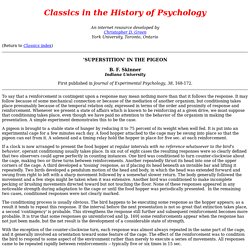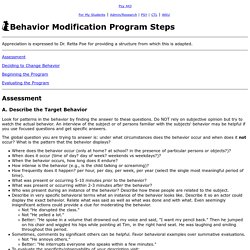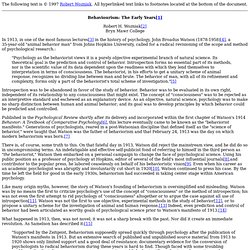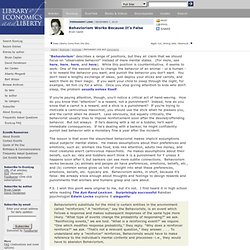

Microsoft Word - Kohn Ch 8.doc - 350kPEEKohnCh8.pdf. Skinner (1948) Classics in the History of Psychology An internet resource developed byChristopher D.

Green York University, Toronto, Ontario (Return to Classics index) B. F. First published in Journal of Experimental Psychology, 38, 168-172. To say that a reinforcement is contingent upon a response may mean nothing more than that it follows the response. A crawling robot: a Q-learning example. Behavior Modification Program Steps. Psy 443 Appreciation is expressed to Dr.

Retta Poe for providing a structure from which this is adapted. Assessment Deciding to Change Behavior Beginning the Program Evaluating the Program Assessment. Behaviorism. The following text is © 1997 Robert Wozniak.

All hyperlinked text links to footnotes located at the bottom of the document. Behaviourism: The Early Years[1] Robert H. Wozniak[2] Bryn Mawr College In 1913, in one of the most famous lectures[3] in the history of psychology, John Broadus Watson (1878-1958)[4], a 35-year-old "animal behavior man" from Johns Hopkins University, called for a radical revisioning of the scope and method of psychological research "Psychology as the behaviorist views it is a purely objective experimental branch of natural science. Introspection was to be abandoned in favor of the study of behavior. Published in the Psychological Review shortly after its delivery and incorporated within the first chapter of Watson's 1914 Behavior: A Textbook of Comparative Psychology[6], this lecture eventually came to be known as the "behaviorist manifesto. " Article. Psychology pioneer Albert Bandura puts his theories to work helping people to believe in themselves and change their world.

Albert Bandura keeps a special box tucked away on a shelf in a small storage room in Jordan Hall. Inside are yellowing index cards and letters grown thin with age. Most ask simply for a reprint of an article the Stanford psychologist wrote 45 years ago titled “Psychotherapy as a learning process” (Psychological Bulletin 58, 1961). But Bandura has saved them all these years because they were sent by some of the best-known psychologists of the day—Joseph Wolpe, Joseph Zubin, Hans Eysenck. Those key thinkers recognized Bandura’s work as a turning point. As the originator of social cognitive theory, Bandura has been called the greatest living psychologist. Behaviorism Works Because It's False. "Behaviorism" describes a range of positions, but they all claim that we should focus on "observable behavior" instead of mere mental states.

(For more, see here, here, here, and here). While this position is counterintuitive, it seems to work: One of the easiest ways to change the behavior of an animal - or a human - is to reward the behavior you want, and punish the behavior you don't want. You don't need a lengthy exchange of ideas; just deploy your sticks and carrots, and watch them do their magic. If you want your child to sleep through the night, for example, let him cry for a while. Once you stop giving attention to kids who don't sleep, the problem usually solves itself. If you're paying attention, though, you'll notice a critical act of hand-waving. The lesson is that even the staunchest behaviorist makes implicit assumptions about subjects' mental states. BAAM Behaviorism Deathwatch. Behaviorism is dead.

The few protected remnants in the universities have no intellectual vitality, and the occasional recitation of behaviorist slogans by the practitioners of behavior modification has little to do with the actual success or utility of their methods. Robert L. Campbell (1999) Campbell, R. L.. (1999). When you restrict your definition of institution to behavior alone, then you eliminate all of the cognitive, emotional, and spiritual aspects of social mechanisms. Loren Cobb (2005) Comment on: Powelson, J. (2005). But times have changed.
Chris Swoyer (2006) Swoyer, C. (2006). One breakthrough I noticed in the materials we read and what we heard is that basically behaviorism is dead. Peter Lawler (2004) Neuroscience, Brain, and Behavior III: Council Discussion (President's Council on Bioethics, April 1, 2004) HTML. Behavior Modification Program Steps. Skinner Air Crib. Skinner's Air Crib 1944, B.F.

Skinner and his wife, Yvonne, were expecting their second child. After raising one baby, Skinner felt that he could simplify the process for parents and improve the experience for children. Through some tinkering, he created the “air crib,” a climate controlled environment for an infant. One of these air cribs resides in the gallery at the Center for the History of Psychology in Akron, Ohio. Skinner had high hopes that the air crib would ease parental burdens and contribute positively to children’s development. J Exp Anal Behav Volume 84(3); November 2005. Behaviorism in Classroom. Igoy Eirene Bf Skinner. Psychology History. Skinner was never highly influenced by critical reactions, he is not interested in the right or wrong because they are either effective or ineffective, and arguments of no avail.

For that reason he is not interested in psychological theories, rational equations, or other verbal systems that are required to be proven right.